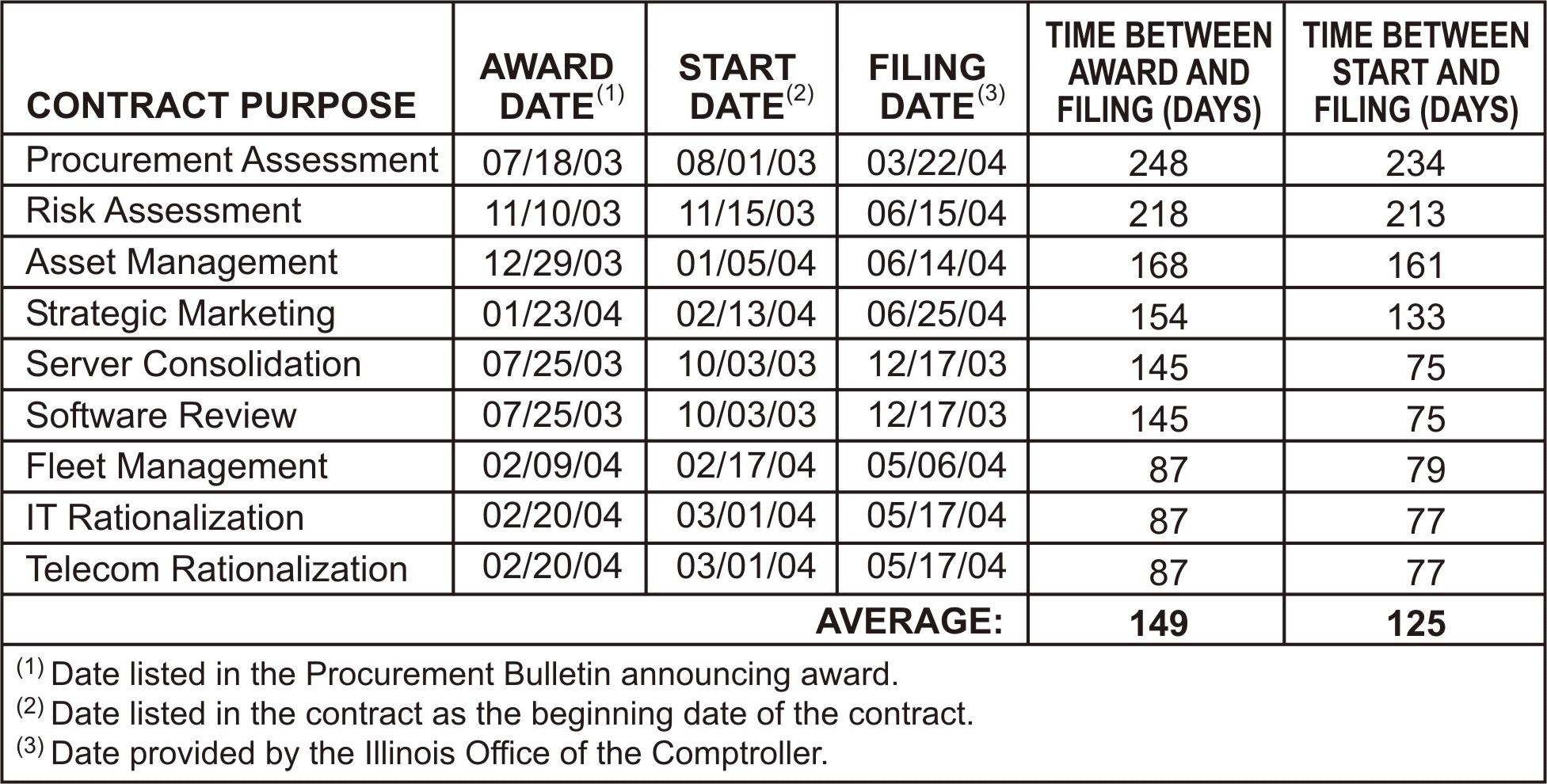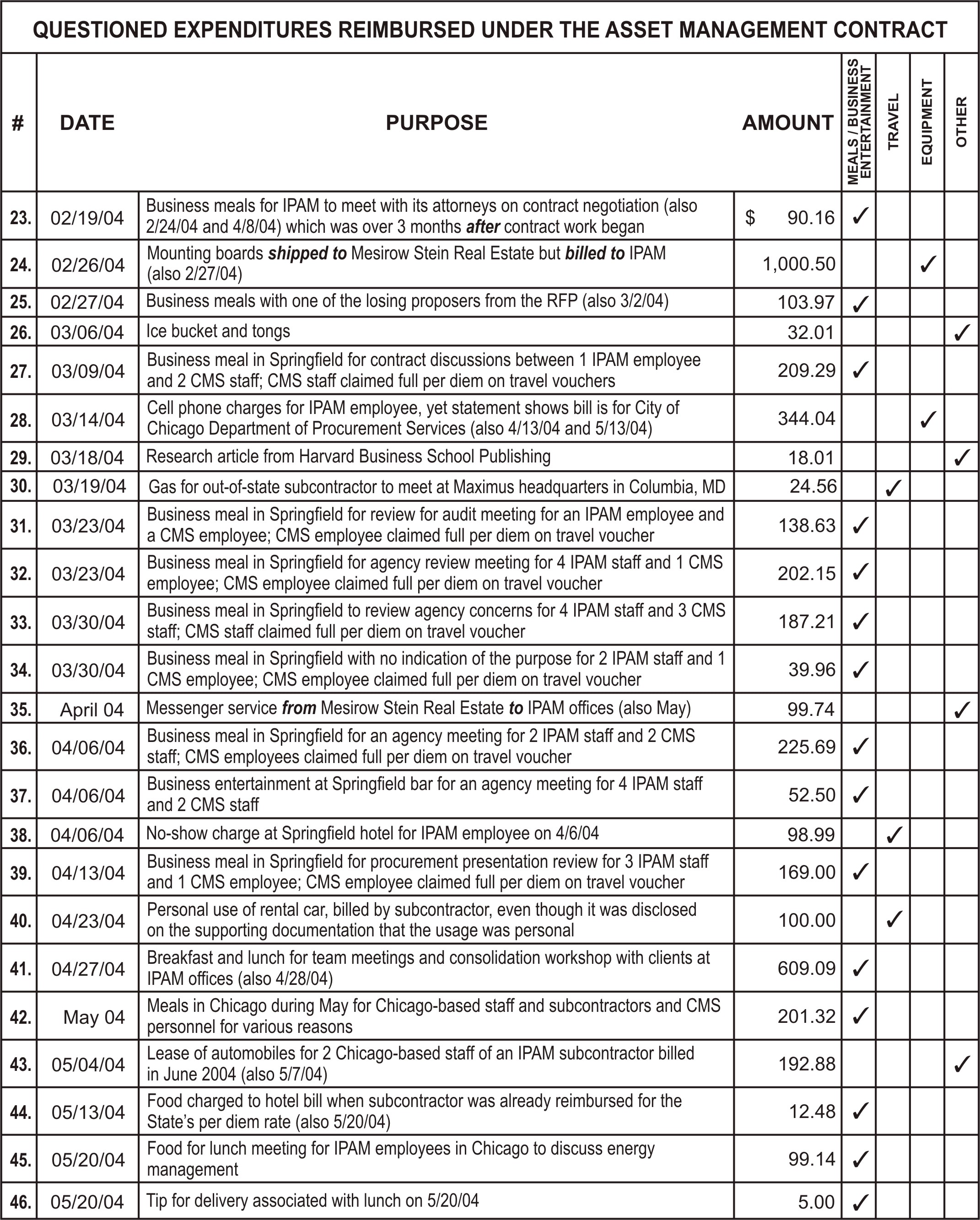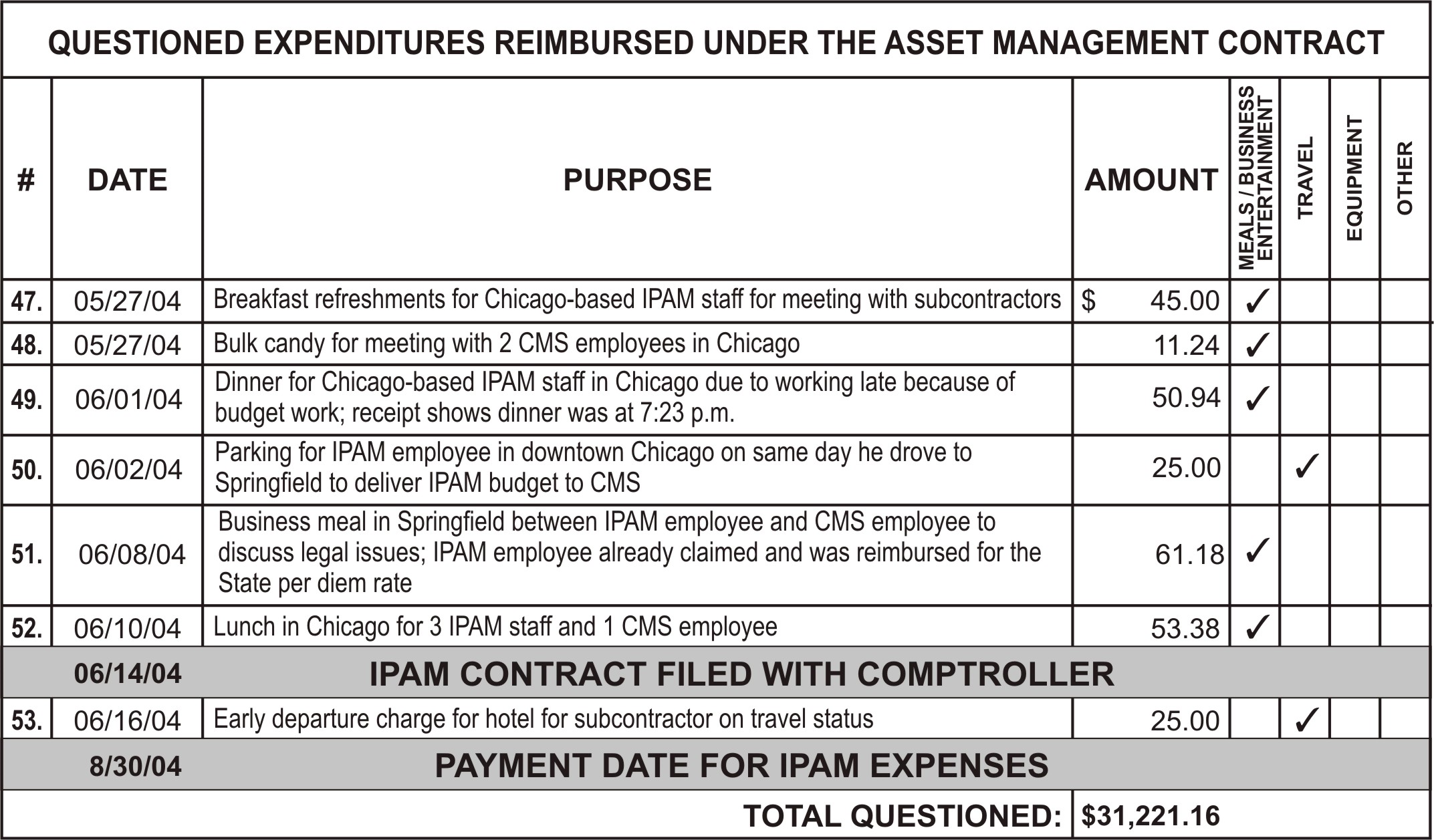|
Our review of procurement files and interviews with
Department staff found that:
§
The Department utilized McKinsey and Company, Inc.
(McKinsey) to gather information on procurement spending by State
agencies. According to a Department
official, this work was performed on a pro bono basis for the State. McKinsey was listed as the source for much
of the factual information in the Procurement Assessment RFP.
§
The Department utilized Accenture to perform a
strategy study in the IT area.
Expenditure information in the IT Rationalization RFP was attributed
to Accenture, LLP.
§
The Department utilized Team Services, LLC (Team
Services), under a non-competitively bid contract, to provide contractual
assistance to the Department in an extremely similar project to what was
eventually awarded to Team Services as the Strategic Marketing
Initiative. The work performed on
this no-bid contract overlapped with the issuance of the RFP for the Strategic
Marketing Initiative.
The Department has adopted general guidelines that prohibit a
person who prepared the specifications from submitting a bid or proposal
unless the agency head determines in writing that accepting such a bid or
proposal would be in the State's best interest (44 Ill.Adm.Code 1.2050
(i). A notice to that effect must be
published in the Procurement Bulletin.
From our review of the procurement files for these contracts,
we could not find evidence the Department determined in writing that there
would be no substantial conflict of interest by allowing vendors to assist in
specification development and bid on the procurement opportunity and that it
was in the best interest of the State to accept bids from these vendors. Notices also were not posted in the
Procurement Bulletin – as required by the Illinois Administrative Code.
We also noted that the Department had a non-State employee
review the RFP for the Procurement Assessment prior to the release of the
RFP. This individual subsequently was
named as partnering with the winning vendor, McKinsey, in its proposal. (Finding Code No. 04-3, page 19)
We recommended that the Department review its process for
utilizing vendors to provide assistance in developing specifications and
information to be included in Requests for Proposals so as to not prejudice
the rights of other prospective bidders or offerors and the public.
The
Department disagreed with the auditor's findings.
CHANGES
IN AWARD EVALUATION CRITERIA NOT COMMUNICATED TO PROPOSERS
The Department evaluated vendor proposals using evaluation
criteria that was not stated in the Request for Proposals (RFP). Changes in scoring methodology were not
communicated to proposing vendors or reflected in an addendum to the RFPs. Additionally, in one of these instances,
the Department awarded a contract to a vendor that had not received the
highest scoring total based on evaluation criteria set out in the RFP.
The Illinois Administrative Code states that proposals shall
be evaluated only on the basis of evaluation factors set forth in the
RFP. (44 Ill. Adm. Code 1.2035
(h)(2)). However, we found in 44
percent (4 of 9) of the contracts we reviewed, the Department used different
criteria when evaluating the price component of the proposals. For instance, in the Risk Assessment,
Server Consolidation, and Software Review contracts, the RFP's identified a
single formula for evaluating pricing while, in practice, the Department used
two pricing categories - one for fixed price and another for a blended
rate. However, we noted that this
change in evaluation methodology - while not communicated to proposers - did
not appear to affect the contract award.
A similar problem was noted with the Fleet Management contract.
We recommended that the Department follow evaluation criteria
stated in Requests for Proposals when evaluating and awarding State
contracts. Additionally, the
Department should develop addendum to Request for Proposals when it
determines there needs to be a change to the evaluation criteria so that all
vendors are assured of a fair and open contracting process.
The Department disagreed with the finding.
EXTENSIVE VENDOR REVISIONS TO PROPOSAL
DURING BEST AND FINAL PROCESS
The Department allowed a vendor to extensively revise its
proposal during the best and final process after initial scoring evaluations
were completed. Several items deleted
by the vendor during the best and final process eventually were added back
into the agreement, in the form of contract amendments. The amendments, potentially costing the
State $5.75 million, were entered into after the award of the contract.
Documentation contained in the procurement files for the
Asset Management professional services procurement opportunity showed that only
one proposing vendor, Illinois Property Asset Management, LLC (IPAM), was
provided the opportunity to submit a best and final offer (BAFO). The Department’s correspondence to IPAM
states, “The purpose of this BAFO is to provide you with an opportunity to
enhance the pricing and to improve any of the services offered within your
original proposal.” While the price
decreased from $35.9 million to $24.9 million as a result of the best and
final process, IPAM’s technical proposal also significantly changed. Our review of the original proposal and
BAFO submitted by IPAM noted the following:
Revision of Joint Venture Composition: IPAM did not exist as an entity at the
time proposals were submitted, evaluations were conducted, or an award was
made. In its original proposal, IPAM
was to be a joint venture of two established firms, Mesirow Stein Development
Services and New Frontier Companies, and a “To be determined M/WBE
(minority/women’s business enterprise)” that would represent 20 percent of
the ownership. Background and
staffing qualifications were valued at 475 of 800 (59 percent) of the total
evaluation points. After the
initial proposals had been scored for background and staffing, IPAM dropped
New Frontier Companies as one of the joint venture partners. Further, according to Department staff, no
M/WBE firm had been named by IPAM as of December 14, 2004.
Revision of Performance Guarantee: The performance guarantee was valued at 50 of 800 (6
percent) total evaluation points. In
its BAFO, IPAM revised the performance guarantee from 5 items in the original
proposal down to 2 in the BAFO. A
Department official noted that IPAM did not hit its $14 million savings goal
in FY04 but that the IPAM fee was not adjusted downward because the guarantee
clauses in IPAM’s BAFO did not get incorporated into the final contract.
Facility
Condition Assessments: In the
original IPAM proposal, IPAM would perform all facility condition assessments
on 50 million sq. ft. of State-owned buildings. Within its BAFO, IPAM decreased its price but also proposed
that facility managers (to be hired for the facility management consolidation
process) and not IPAM would perform the condition assessments on the
last 40 million square feet. However,
on February 4, 2005, the Department
published in the Procurement Bulletin a sole source $2.25 million contract
for IPAM to perform facility condition assessments.
Lease Administration Services: In the original IPAM proposal, IPAM proposed “…while not
specifically requested by the State in the RFP, IPAM will offer to provide
future lease administration services to the State on an ongoing basis once
the new system is operational.” The
BAFO submitted by IPAM contained the exact language as the original proposal
with the inclusion of “for an additional fee” at the end of the sentence
quoted above. When questioned on
whether this “additional fee” was outside the purpose of the best and final
process, Department officials indicated that the additional fee was not
outside the process because the services were not part of the original RFP
anyway. On January 20, 2005, the
Department amended the contract with IPAM to increase the contract amount by
$3.5 million for lease transaction services.
(Finding Code No. 04-5, page 25)
We recommended that the Department allow vendors to only
revise sections of proposals as stated within the purpose for requesting a
best and final offer.
The Department disagreed with the finding and recommendation.
FAILURE
TO PUBLISH THAT CONTRACT WAS AWARDED TO OTHER THAN THE LOWEST PRICED VENDOR
The Department failed to provide notification, in the
Illinois Procurement Bulletin, that contracts were awarded to other than the
lowest priced vendor.
Procurement Code provisions applicable to professional and artistic
contracts provide that "when the contract exceeds the $25,000 threshold
and the lowest bidder is not selected, the chief procurement officer or the
State purchasing officer shall forward together with the contract notice of
who the low bidder was and a written decision as to why another was
selected…[CMS] shall publish…notice of the chief procurement officer’s or
State purchasing officer’s written decision.” (30 ILCS 500/35-30 (f))
The Department's administrative rules similarly require, “If the price
of the best qualified vendor exceeds $25,000, the Procurement Officer, but
not a designee, must state why a vendor other than the low priced vendor was
selected and that determination shall be published in the Bulletin.” (44 Ill. Adm. Code 1.2035 (m)(3))
In 44 percent (4 of 9) of the contracts we reviewed, the
Department awarded the contract to a vendor that was not the lowest priced
proposer and did not publish this in the Procurement Bulletin. (Finding Code No. 04-6, page 28)
We recommended that the Department follow the requirements
set forth in the Illinois Procurement Code and administrative rules and
publish instances where a vendor with the lowest price was not selected for
the award of a contract.
The Department disagreed with the finding.
FAILURE
TO INCLUDE SUBCONTRACTOR INFORMATION IN CONTRACTS
The Department failed to ensure that subcontractor
information required under the Procurement Code was included in contracts
awarded by the Department. In 44
percent (4 of 9) of the contracts we reviewed, the Department failed to have
information on subcontractors utilized by the selected vendor included in the
contract. The Department estimated
the value of these contracts to be approximately $53 million.
For professional and artistic contracts only, the contracts
must state, “whether the services of a subcontractor will be used. The contract shall include the names and
addresses of all subcontractors and the expected amount of money each will receive
under the contract.” If a contractor
adds or changes any subcontractors, CMS must receive the foregoing
information in writing in a prompt manner.
(30 ILCS 500/35-40)
For instance:
§
Asset Management Contract: The IPAM contract does not identify any of
the subcontractors utilized by IPAM.
Four subcontractors were identified in the IPAM proposal it submitted
to the Department. However, the
amount to be paid to these subcontractors was not disclosed. Furthermore, during our review of expenses
reimbursed by the State to IPAM, we found evidence that one of the IPAM
subcontractors was utilizing subcontractors of their own to perform work.
§
IT Rationalization Contract: The BearingPoint and Accenture contracts
do not identify any of the subcontractors to be utilized during the IT
Rationalization project. The
proposals do identify some subcontractors but not the amounts each would
receive under the contract. In the
Accenture proposal, three subcontractors are identified. However, after we inquired about the use
of subcontractors and how much each received in compensation, a Department
official collected information that shows Accenture used six subcontractors
on this project and paid them a total of $2.6 million. In the BearingPoint proposal, two subcontractors
are identified. A Department official
collected information that shows BearingPoint subcontracted with eight firms
on this project and paid them a total of $3.2 million for hourly fees plus
expenses.
§
Telecom Rationalization: The EKI contract did not contain
information on the use of any subcontractors. The proposal submitted by EKI did identify four subcontractors
but with no expected value for compensation.
After we inquired about the use of subcontractors and how much each
received in compensation, a Department official collected information that
showed EKI used four subcontractors on this project – including three
different subcontractors that had never been identified in any document we
examined. In documentation supplied
by the Department in February 2005, one of these three subcontractors that
had not been listed in either the contract or the proposal had received $3.2
million from EKI for subcontracting work.
The same documentation showed that EKI had made $1.3 million – or less
than half of what the subcontractor had received.
§
Software Review: In the contract between BearingPoint and the Department (in the
section that allows subcontracting) BearingPoint does assert that it “is
proposing to use an independent consultant to complete a portion of the required
consulting services.” The
subcontractor is not identified in the contract. Department officials did not provide us with information on a
subcontractor or any amount paid by the primary contractor to a
subcontractor. (Finding Code No.
04-7, page 31)
We recommended that the Department follow the direction of
the Illinois Procurement Code and include information on subcontractors and
the amounts to be paid to the subcontractors under the contracts.
The Department disagreed with the finding.
NOT
TIMELY IN EXECUTING CONTRACTS
The Department was not timely in executing contracts with
vendors for contracts awarded.
Additionally, the Department allowed vendors to initiate work on these
projects without a written contract in place.
In 100 percent (9 of 9) of the contracts we reviewed, the
Department allowed vendors to initiate work on the project without a formal
written agreement in place. These
contracts were estimated by the Department to have a maximum contract value
of $69 million with an FY04 financial commitment of $32 million. On average, the length of time between the
announcement of the award and the filing of a contract with the
Comptroller was 149 days (with a range of 87 days to 248 days). The average length of time between beginning
work on the contract and the filing of the contract with the
Comptroller was 125 days (with a range of 75 days to 234 days). The table below provides a breakdown for
all nine contracts reviewed:
|









